#Bangladesh River Foundation
Text
BANGLADESH: Seminar on the rights of rivers.

In Bangladesh:
⦁ The great efforts of the Bangladesh River Foundation in association with Bangladeshi Conservationists for River Conservation and Environment (ABCR) who will hold a 2-day celebration starting at different places along the Buriganga River and ending with an Art Camp for River Conservation. Activities include a Policy Discussion Seminar on the rights of rivers, a Mime Show Against River Pollution, and a special showing of Art and Photography for the River.
⦁ The River and Delta Research Center (RDRC) will be hosting a very special Rivers Day 5A side football tournament in Dhaka, Bangladesh
Events WRD2023 - Bangladesh.
#River and Delta Research Center (RDRC)#Bangladesh River Foundation#pollution remediation#Rights of rivers#art photography#bangladesh#24 september#world rivers day
0 notes
Photo

Mughal India c. 1707
A map illustrating the emergence and expansion of one of the largest centralized states in the premodern world - the Mughal (Persian for Mongol) Empire from its foundation in 1526 by Ẓahīr al-Dīn Muḥammad Babur, a Chagatai Turk and a descendant of both Timur and Genghis Khan until its heyday under Aurangzeb in the early 1700s when it held a population of between 100 and 150 million and covered almost the entire Indian subcontinent from the edges of the Indus river basin, Afghanistan and Kashmir to the present-day Assam and Bangladesh highlands and south to the uplands of Deccan. The Mughal empire commanded resources unprecedented in Indian history and, in sheer size, surpassed its two rival Islamic empires - Safavids and Ottomans, being comparable only to Imperial China of the time.
45 notes
·
View notes
Text
Satkhira - Healthcare Facilities and Ambulance Services
Satkhira is one of the 64 districts of Bangladesh, located in the southwest, and is a part of Khulna Division. Situated near the border with India, Satkhira intersects the Ichamati and Betna rivers, contributing to the greenery and fertile plains. The district is renowned for its shrimp farming industry, playing a vital role in the economy. Their healthcare, on the other hand, does not match up. The district needs a lot of work in their healthcare area. Even though their infrastructures include both private and government hospitals and healthcare facilities, they still lack advanced medical services and specialised healthcare professionals. The problems of quality healthcare still persists, especially around rural areas.
Some of the hospitals available in Jashore are,
Satkhira Sadar Hospital
Satkhira Medical College & Hospital
China Bangla Hospital, Satkhira
CB Hospital Ltd
Sangram Hospital
Bushra Hospital Satkhira
Islami Bank Community Hospital Satkhira Ltd
Satkhira National Hospital
Doctor's Lab & Hospital Satkhira
Satkhira Children's Hospital
Digital Diagnostic Center & SD Hospital
Care Diagnostic Centre & Clinic
Satkhira Specialized Hospital
Heart Foundation & Intensive Care Hospital
Grameen Eye Hospital, Satkhira
Care Hospital
Satkhira Sadar Hospital Masjid
Drishti Eye Hospital Satkhira Ltd
Even with a multitude of hospitals, addressing critical health emergencies remains a challenge as these facilities lack essential equipment and specialised medical staff for comprehensive patient care. Consequently, patients often need to seek treatment elsewhere. Ensuring the well-being of these individuals during transportation is vital, requiring healthcare professionals to ensure the patient's health doesn't worsen. This underscores the necessity for ambulance services to uphold the stability of the patient's condition during transit.
To ensure the well-being of these diverse patients, emergency healthcare services provide thorough ambulance assistance, which include,
Standard or Basic Ambulances
Intensive Care Unit (ICU) Ambulances
Neonatal Intensive Care Unit (NICU) Ambulances
Air Ambulances
Advanced Life Support (ASL) Ambulances
Ambulances for Transporting Deceased Bodies
Given that numerous patients frequently need medical assistance from other cities like Dhaka, ambulance services play a crucial role in maintaining their health stability during transportation. These ambulances are equipped with all the necessary elements to stabilise critical patients. Apart from Standard Ambulances and those designated for transporting deceased bodies, these vehicles essentially function as compact Intensive Care Units (ICUs), containing all the essential equipment and facilities typically found in a full-scale ICU.
These ambulances (except Standard Ambulances and Ambulances for Transporting Deceased Bodies) are equipped with,
Bi-phasic Defibrillator
Automatic external Defibrillator (AED)
Cardiac Monitor
Recorder
Ventilators
Suction Pump (electronic and manual)
Infusion Pump
Syringe Pump
Volumetric Pump
Artificial Manual Breathing Unit (adult, child and neonatal)
Mouth to Mask Ventilation Device
Pulse Oxymeter
Fluid and Blood Warmer
Roll-in Cot Main Stretcher (Manual or Auto loading)
Foldable secondary stretcher
Spine Board with restraint set
Resuscitator Adult with Overpressure Valve
Cervical Collar different size (set of 6)
Dual Head Stethoscope
Wall-Mounted Sphygmomanometer
Portable O2 Cylinder – D Size with regulator
Portable Suction Unit
Stair Chair stretcher
Head Immobiliser
Scoop Stretcher
Traction Devices
Extrication Devices
Compression Device
First Aid Kit
Vacuum Mattress
In terms of staffing, these ambulances are manned by skilled and certified healthcare professionals, such as paramedics and Emergency Medical Technicians (EMTs), who possess the expertise to manage diverse medical emergencies. Their extensive training over several years enables them to effectively serve critical patients.
Ambulance services aim to provide timely and effective medical care, ensuring that patients receive the necessary interventions to stabilise their health en route to medical facilities.
0 notes
Text
MS River Sand Stone Aggregates—Pioneering Excellence in Bangladesh's Construction Industry
MS River Sand Stone Aggregates, a distinguished supplier and manufacturer of construction aggregates based in Sunamganj, Bangladesh, proudly stands as a beacon of quality and reliability in the realm of crushed stone chips and aggregates.
A Legacy of Excellence: Established as a cornerstone in the construction landscape of Bangladesh, MS River Sand Stone Aggregates has earned a stellar reputation for consistently delivering top-notch crushed stone chips and aggregates. Our commitment to quality has positioned us as a trusted partner for projects ranging from small-scale initiatives to expansive construction endeavors.
Our Comprehensive Offerings: Specializing in a range of construction materials, we provide:
20mm Aggregates
3/4 Stone chips
3/4 crushed stone
Limestone Dust
• Crushed Stone: Unparalleled in quality, our crushed stone serves as the foundation for sturdy construction projects.
• Stone Chips: We supply premium ¾ stone chips that meet the stringent standards demanded by the industry.
• Limestone Dust: An essential component for various applications, our limestone dust contributes to the success of diverse construction ventures.
• Aggregates: From small residential developments to large-scale infrastructure projects, our 20 mm aggregates have been the cornerstone of success for builders across Bangladesh.
Unrivaled Expertise: MS River Sand Stone Aggregates takes pride in being the go-to supplier for best-in-class 20mm aggregates and superior 3/4 stone chips. Our commitment to precision ensures that our 3/4 crushed stone boasts accurate sizing, catering to the exacting needs of our clients.
Reliability You Can Count On: Recognized as the most reliable aggregate supplier in Bangladesh, we are dedicated to providing consistent quality and timely delivery to support the smooth progression of construction projects.
Contact Us: For more information or to explore how MS River Sand Stone Aggregates can elevate your construction projects, please feel free to reach out to us at: +8801726601477
Your Trusted Partner in Construction Aggregates: MS River Sand Stone Aggregates remains steadfast in its mission to supply the best-quality construction Aggregate materials, contributing to the success of builders and developers throughout Bangladesh.
Visit our website for more details: on Stone chips and crushed stone
1 note
·
View note
Text
DHAKA, Bangladesh (AP) — Thousands of people hunkered down Sunday in monasteries, pagodas and schools, seeking shelter from a powerful storm that slammed into the coast of Myanmar, tearing the roofs off buildings and killing at least three people.
The center of Cyclone Mocha made landfall Sunday afternoon in Myanmar’s Rakhine state near Sittwe township wind speeds up to 209 kilometers (130 miles) per hour, Myanmar’s Meteorological Department said. Earlier, the storm passed over Bangladesh’s Saint Martin’s Island, causing damage and injuring people, but turned away from the country’s shores before landfall.
Myanmar’s military information office said the storm had damaged houses, electrical transformers, cell phone towers, boats and lampposts in Sittwe, Kyaukpyu, and Gwa townships. It said the storm also tore roofs off of sport buildings on the Coco Islands, about 425 kilometers (264 miles) southwest of the country’s largest city, Yangon.
Rakhine-based media reported that streets and basements of the houses in Sittwe’s low-lying areas were flooded, and that people in low-lying areas were trapped in their houses and unable to communicate. Much of the area is cut off from telephone and internet service after high winds crumpled cell phone towers.
More than 4,000 of Sittwe’s 300,000 residents were evacuated to other cities and more than 20,000 people are sheltering in sturdy buildings such as monasteries, pagodas and schools located on the city’s highlands, said Tin Nyein Oo, who is volunteering in shelters in Sittwe.
Lin Lin, the chairman of a local charitable foundation, said earlier there was not enough food in the shelters in Sittwe after more people arrived than expected.
Titon Mitra, the U.N. Development Program representative in Myanmar, tweeted: “Mocha has made landfall. 2m people at risk. Damage and losses are expected to be extensive. We are ready to respond and will need unhindered access to all affected communities.”
On Sunday morning, several deaths caused by wind and rain were reported in Myanmar. A rescue team from the country’s eastern Shan state announced on its Facebook social media page that they had recovered the bodies of a couple who were buried when a landslide caused by heavy rain hit their house in Tachileik township. Local media reported that a man was crushed to death when a banyan tree fell on him in Pyin Oo Lwin township in the central Mandalay Region.
Authorities in the Bangladeshi city of Cox’s Bazar, which lay in the storm’s predicted path, said earlier that they had evacuated hundreds of thousands of people, but by early afternoon it appeared that the storm would mostly miss the country as it veered east, said Azizur Rahman, director of the Bangladesh Meteorological Department in Dhaka.
“The level of risk has reduced to a great extent in our Bangladesh,” he told reporters.
Strong winds accompanied by rains continued in the Saint Martin’s Island in the Bay of Bengal in the afternoon, but feared tidal surges did not take place because the cyclone started crossing Bangladesh coast at low tide, Dhaka-based Jamuna TV station reported.
About a dozen islanders were injured, while some 300 homes were either destroyed or damaged, leading Bengali-language Prothom Alo daily reported. One woman was critically wounded, it said.
U.N. agencies and aid workers in Bangladesh had prepositioned tons of dry food and dozens of ambulances with mobile medical teams in sprawling refugee camps that house more than 1 million Rohingya who fled persecution in Myanmar.
In May 2008, Cyclone Nargis hit Myanmar with a storm surge that devastated populated areas around the Irrawaddy River Delta. At least 138,000 people died and tens of thousands of homes and other buildings were washed away.
Roxy Mathew Koll, a climate scientist at the Indian Institute of Tropical Meteorology in Pune city, said cyclones in the Bay of Bengal are becoming more intense more quickly, in part because of climate change.
Climate scientists say cyclones can now retain their energy for many days. Cyclone Amphan in eastern India in 2020 continued to travel over land as a strong cyclone and caused extensive devastation.
“As long as oceans are warm and winds are favorable, cyclones will retain their intensity for a longer period,” Koll said.
Cyclones, giant storms similar to those known as hurricanes or typhoons in other parts of the world, are among the world’s most devastating natural disasters, especially when they hit densely populated coastal regions.
0 notes
Text
Union county Florida foundation repair
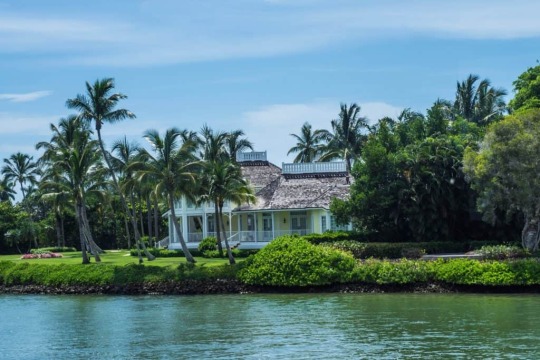
Union county Florida
Union County, Florida is an often overlooked haven of natural beauty, with its diverse ecosystems, unique wildlife, and ample outdoor recreation opportunities.
Located in the North Central Florida, Union County is bordered by Bradford, Alachua and Columbia counties and the Santa Fe River, providing a beautiful and diverse landscape to explore.
From the rolling hills, to the stunning springs, to the rivers and lakes that dot the landscape, Union County has something to offer everyone.
Whether you are looking for a quiet getaway, an outdoor adventure, or a place to simply explore and observe the natural beauty of Florida, Union County is the perfect place to visit.
With its friendly and welcoming people, Union County is one of Florida’s most underrated gems.
In this blog post, we will explore the many elements that make Union County Florida a great destination for both locals and visitors alike.
Hurry! Fill this form to talk to a Florida foundation pro!
* indicates required
First Name
Last Name
Email Address *
Phone Number
Describe briefly what the problem seems to be
Address
Address Line 2
City
State/Province/Region
Postal / Zip Code
Country
USA
Aaland Islands
Afghanistan
Albania
Algeria
American Samoa
Andorra
Angola
Anguilla
Antigua And Barbuda
Argentina
Armenia
Aruba
Australia
Austria
Azerbaijan
Bahamas
Bahrain
Bangladesh
Barbados
Belarus
Belgium
Belize
Benin
Bermuda
Bhutan
Bolivia
Bonaire, Saint Eustatius and Saba
Bosnia and Herzegovina
Botswana
Bouvet Island
Brazil
Brunei Darussalam
Bulgaria
Burkina Faso
Burundi
Cambodia
Cameroon
Canada
Cape Verde
Cayman Islands
Central African Republic
Chad
Chile
China
Christmas Island
Colombia
Comoros
Congo
Cook Islands
Costa Rica
Cote D'Ivoire
Croatia
Cuba
Curacao
Cyprus
Czech Republic
Democratic Republic of the Congo
Denmark
Djibouti
Dominica
Dominican Republic
Ecuador
Egypt
El Salvador
Equatorial Guinea
Eritrea
Estonia
Ethiopia
Falkland Islands
Faroe Islands
Fiji
Finland
France
French Guiana
French Polynesia
Gabon
Gambia
Georgia
Germany
Ghana
Gibraltar
Greece
Greenland
Grenada
Guadeloupe
Guam
Guatemala
Guernsey
Guinea
Guyana
Haiti
Honduras
Hong Kong
Hungary
Iceland
India
Indonesia
Iran
Iraq
Ireland
Isle of Man
Israel
Italy
Jamaica
Japan
Jersey (Channel Islands)
Jordan
Kazakhstan
Kenya
Kiribati
Kuwait
Kyrgyzstan
Lao People's Democratic Republic
Latvia
Lebanon
Lesotho
Liberia
Libya
Liechtenstein
Lithuania
Luxembourg
Macau
Macedonia
Madagascar
Malawi
Malaysia
Maldives
Mali
Malta
Marshall Islands
Martinique
Mauritania
Mauritius
Mayotte
Mexico
Moldova, Republic of
Monaco
Mongolia
Montenegro
Montserrat
Morocco
Mozambique
Myanmar
Namibia
Nepal
Netherlands
Netherlands Antilles
New Caledonia
New Zealand
Nicaragua
Niger
Nigeria
Niue
Norfolk Island
North Korea
Norway
Oman
Pakistan
Palau
Palestine
Panama
Papua New Guinea
Paraguay
Peru
Philippines
Pitcairn
Poland
Portugal
Qatar
Republic of Kosovo
Reunion
Romania
Russia
Rwanda
Saint Kitts and Nevis
Saint Lucia
Saint Martin
Saint Vincent and the Grenadines
Samoa (Independent)
San Marino
Sao Tome and Principe
Saudi Arabia
Senegal
Serbia
Seychelles
Sierra Leone
Singapore
Sint Maarten
Slovakia
Slovenia
Solomon Islands
Somalia
South Africa
South Georgia and the South Sandwich Islands
South Korea
South Sudan
Spain
Sri Lanka
Sudan
Suriname
Svalbard and Jan Mayen Islands
Swaziland
Sweden
Switzerland
Syria
Taiwan
Tajikistan
Tanzania
Thailand
Timor-Leste
Togo
Tonga
Trinidad and Tobago
Tunisia
Turkey
Turkmenistan
Turks & Caicos Islands
Uganda
Ukraine
United Arab Emirates
United Kingdom
Uruguay
Uzbekistan
Vanuatu
Vatican City State (Holy See)
Venezuela
Vietnam
Virgin Islands (British)
Virgin Islands (U.S.)
Western Sahara
Yemen
Zambia
Zimbabwe
Marketing Permissions
Please select all the ways you would like to hear from Florida Foundation Pro:
Email phone
You can unsubscribe at any time by clicking the link in the footer of our emails. For information about our privacy practices, please visit our website.
We use Mailchimp as our marketing platform. By clicking below to subscribe, you acknowledge that your information will be transferred to Mailchimp for processing. Learn more about Mailchimp's privacy practices here.
Where is Union county in Florida and what is there to do?
Union County, located in the heart of North Central Florida, is an area of tremendous natural beauty and a great place to live, work, and play.
The county is home to the City of Lake Butler, which is the county seat, as well as Worthington Springs, Providence, and Raiford.
Union County is known for its many outdoor activities such as fishing, camping, biking, and bird watching.
Tourists can explore the area’s many parks, lakes, rivers, and springs, as well as the historic sites such as the Town of Raiford and the Union County Historic Courthouse.
The area hosts several annual events such as the Union County Fair, a Civil War re-enactment, and a Fourth of July parade. Union County’s rich history and culture make it a great place to visit and explore.

Should I buy a house in Union county, FL?
The decision to buy a house in Union County, FL should be carefully considered.
It is important to assess if the area meets your needs in terms of lifestyle, job opportunities, and affordability.
Homeownership can bring a sense of stability and pride, and Union County has a strong housing market with a mixture of new and established neighborhoods.
The cost of living in the area is generally lower than the national average and the county has seen steady job and population growth in recent years.
With its access to arts, culture, and recreation, Union County could be an ideal place to buy a home. However, it is always wise to invest in research and speak with local experts before making any major decisions.
Ultimately, whether you decide to buy in Union County or elsewhere is a personal choice.
What are the house foundation problems in Union county Florida and how can they be repaired?
House foundation problems in Union County, Florida can include issues such as shifting, cracking, settling, and bowing.
These problems can be caused by a variety of factors, such as soil erosion, water saturation, or inadequate drainage.
To properly repair house foundation problems, an experienced contractor should be consulted.
The contractor will need to assess the severity of the issue and develop a solution tailored to the individual needs of the property.
Repair options may include underpinning, releveling, or replacing foundation walls and footings.
Utilizing the appropriate solutions can ensure that the foundation problem is repaired in a safe and effective manner.
In conclusion, Union County, Florida is a great place to live and invest in real estate.
There is plenty to do here and it is a wonderful place to raise a family.
It is important to be aware of the potential house foundation problems in Union County and to take the necessary steps to ensure that these issues are addressed properly.
With the right knowledge and guidance, Union County provides an excellent environment for anyone looking to purchase and enjoy their own home.
Read the full article
#floridafoundation#FloridafoundationPro#Floridafoundationrepair#FloridafoundationrepairUnioncountyFlorida#UnioncountyFlorida
0 notes
Text
Nodi Rocks Concert for Climate & River coming on 23rd

Nodi Rocks will be organizing their first concert on September 23 at Novoratri - 4 Hall of the International Convention City Bashundhara (ICCB).
For the first time in the country, Salt Creatives has taken this groundbreaking initiative by uniting climate, rivers, youth, and music. Popular Bangladeshi bands CrypticFate, Chirkutt, Arbovirus, and Ashes will be performing at the concert.
Along with them, Bangla 5, FMinor, and Smooches will rock the stage too.
For the first season of the project, sever popular bands made songs on seven rivers — Padma, Kushiyara, Sangu, Chitra, Pashur, Dahuk, and Buriganga.
The "Nodi Rocks" initiative is starting with devotion to rivers and 7 popular Bands, a revolutionary initiative with a view to using music as a powerful tool to promote the riverine beauty and create awareness to preserve climate among the youth.
The people involved with the ‘Nodi Rocks’ project hope that eventually, there will be a song for each river in the country, so that awareness for preserving the climate and rivers would grow, especially among the young generation.
In addition, there will be lots of arrangements in the program and the concert gate will be open at 2:30 pm.
The initiative is being supported by the Swiss Embassy and the Manusher Jonno Foundation. Salt Creatives has taken the initiative with the aim of having at least one song on every river in our country.
Brandmyth Experiential is hosting this concert alongside its partners Shobai Mile Shobar Dhaka, LafargeHolcim Bangladesh Limited Remark HB Limited, Radio Today, Bangladeshi Band Music Fans Community - BBM FC, Metal Freak T-shirt Nestle, and Polar.
Read the full article
0 notes
Video
youtube
The Padma Multipurpose Bridge (Bengali: পদ্মা বহুমুখী সেতু, romanized: Pôdma Bôhumukhī Setu), commonly known as the Padma Bridge (Bengali: পদ্মা সেতু, romanized: Pôdma Setu), is a two-level road-rail bridge across the Padma River, the main distributary of the Ganges in Bangladesh. It connects Shariatpur and Madaripur, linking the less developed southwest of the country to the northern and eastern regions. The bridge was inaugurated on 25 June 2022 by the Prime Minister Sheikh Hasina. The bridge is considered to be the most challenging construction project in the history of Bangladesh, the steel truss bridge carries a four-lane highway on the upper level and a single track railway on the lower level. The bridge consists of 41 sections, each 150.12 m (492.5 ft) long and 22.5 m (74 ft) wide, with a total length of 6.15 km (3.82 mi). It is the longest bridge in Bangladesh, the longest bridge over the river Ganges (Gaṅgā) by both span and total length, and features the highest pile depth of any bridge in the world at 120 m (390 ft). It is the deepest bridge in the world, with piles installed as deep as 127 metres. The bridge, when commissioned, is expected to boost the GDP of Bangladesh by as much as 1.2 percent. History The foundation stone for Padma Bridge was laid by Prime Minister Sheikh Hasina on 4 July, 2001. However, the BNP under the leadership of Khaleda Zia returned to power following the 2001 general election and decided to discontinue the project. In the 2006-2007 Annual Development Program, the then Government of Bangladesh adopted a plan to build the Padma Multipurpose Bridge. The Bangladesh Bridge Authority (BBA) invited the pre-qualification tender for the project in April 2010. Construction of the bridge was expected to commence by early 2011[17] and be ready for major completion in 2013 (and complete all sections by late 2015[unreliable source?]). After allegations of corruption by some people associated with the project's preparation, the World Bank withdrew its commitment and other donors followed. The Government of Bangladesh then decided to fund the project itself. On 17 June 2014, important progress had been made in the construction of the Padma Multipurpose Bridge. A construction firm, China Major Bridge Engineering Company Ltd, was selected to construct the long aspired bridge on the river Padma. The 6.15 km bridge cost an estimated ৳91.72 billion (US$980 million). Usage and benefits The bridge will connect Dhaka with Kolkata in a faster way. At least 2 hours journey time will be saved. Southern part of Bangladesh will be connected with Dhaka in a shorter time. Once the bridge is operational, another Kolkata-Dhaka International train via Mawa, Goalando, Faridpur, Kushthia, Poradaho, Darshana & Gede may be introduced. Toll and revenue টোল হার (টাকা) মোটর সাইকেল:১০০ কার, জীপ:৭৫০ পিকআপ:১২০০ মাইক্রোবাস:১৩০০ ছোট বাস (৩১ আসন বা এর কম):১৪০০ মাঝারি বাস ( ৩২ আসন বা এর বেশি):২০০০ বড় বাস (৩ এক্সেল):২৪০০ ছোট ট্রাক (৫ টন পর্যন্ত):১৬০০ মাঝারি ট্রাক (৫ টনের অধিক হতে ৮ টন পর্যন্ত):২১০০ মাঝারি ট্রাক (৮ টনের অধিক হতে ১১ টন পর্যন্ত):২৮০০ ট্রাক (৩ এক্সেল পর্যন্ত):৫৫০০ ট্রেইলার (৪ এক্সেল পর্যন্ত):৬০০০ ট্রেইলার (৪ এক্সেলের অধিক):৬০০০+ প্রতি এক্সেল ১৫০০ On 28 April 2022, the Bridges Division proposed a toll rate for the Padma Bridge and sent it to Prime Minister Sheikh Hasina for approval. On May 17, the Ministry of Road Transport and Bridges issued a notification fixing different toll rates for different transports. The construction cost of the Padma bridge is Tk. 30,193.39 crore. It is estimated that by 2022, the bridge will carry 21,300 vehicles per day in 23 districts of Bangladesh, which will increase to 41,600 by 2025. It will take 9+1⁄2 years to recover the toll from all of them. According to Jugantar, citing the World Bank, the revenue from the Padma Bridge in the next 31 years will be 18.5 billion dollars, which is 5.5 times the construction cost. In addition, social progress will add 25 billion dollars to the economy. The land that has been protected through river governance on both sides is worth about Tk. 1,400 crore. The bridge will save Tk. 2,400 crore on electricity, gas and internet lines. The non-operation of the ferry will save Tk. 3,600 crore. According to the agreement, the bridge authority will have to pay Tk. 36,000 crore in the next 35 years. According to the Bangladesh Bridge Authority, most of the money collected from the toll will be used to repay the loan and the rest will be used to maintain the bridge. On 26 June 2022, a total of about 15,200 vehicles crossed the bridge in the first eight hours after the authorities opened it to the public at 6 am. According to an offcial from the Bangladesh Bridge Authority, Tk. 82,19,000 toll was collected between 6 am to 2 pm.On 1 July 2022, the government earned record Tk 3,16,00,000 in revenue through toll from 26,394 vehicles that crossed the Padma Bridge, the sixth day after opening of the bridge to traffic.
0 notes
Text
Indian Non-Fiction
A list of books on India, almost all of which are by Indian writers; most of them are about history in one way or other but they also involve politics, culture, and religion. (Doesn’t include writing in Indian languages because most of my non-English reading has been limited to fiction). I’ve also added links to online editions for ones I found.
History
Pre-, Postcolonial India (+ other assorted history)
Land of Seven Rivers by Sanjeev Sanyal - looks at Indian history through its geography; great if you want an introduction. it’s a small book but has very interesting insights; definitely would recommend. Also check his Ocean of Churn, which looks at Indian history in terms of the Indian Ocean
The Lost River: On the Trail of the Sarasvati by Michel Danino - looks into the research and evidence on the existence of the Sarasvati river and makes a case for its existence
Hooghly: The Global History of a River by Robert Ivermee - about Hooghly as a centre of a trans-Asiatic and trans-oceanic commercial network
Indians: A Brief History of a Civilization by Namit Arora - what it says, it’s new and was well-received; it paints a holistic picture to start you off
Modern South India by Rajmohan Gandhi - this one’s new, and I’ve only barely read it. It’s the history of south India from the coming of the Portuguese to modern times and it’s really important because we don’t study about this or even talk about this in mainstream conversations
India Moving by Chinmay Tumbe - on migration within India and how migrants and migrations has shaped history, politics, and policy
The Courtesan, the Mahatma, and the Italian Brahmin by Manu Pillai - a selection of stories (real ones) from Indian history; very engagingly written and very, very interesting stories. Also check other works by Pillai - The Ivory Throne and Rebel Sultans. He also writes a regular column for the Mint
Panipat by Vishwas Patil - (a translation from Marathi) a history of the Battle at Panipat in 1761, which basically created a vacuum for the East India Company to step in and grab power; really expansive and highly detailed
Rama and Ayodhya by Meenakshi Jain - on the Ramayana and its cultural spread across Indian since the ancient times; also about the Ayodhya movement
Decolonizing the Hindu Mind by Koenraad Elst - lays down the ideological and intellectual development of the broad umbrella Hindu revivalist movement; really good starting point to understand the rise and development of a significant chunk of Indian politics in post-independence years; really straightforward work, very clear in its objectives
1962: the War that Wasn’t by Shiv Kunal Verma - on the Sino-Indian conflict in 1962; haven’t read it yet, but it’s supposed to be one of the best ones on the conflict
1971: A Global History of the Creation of Bangladesh by Srinath Raghavan - on the creation of Bangladesh; places the history in a Cold War context and includes all stakeholders like the US, China and Russia; has multiple layers to its narrative.The Most Dangerous Place by Srinath Raghavan - on American foreign policy in South Asia right from the earliest times.
Cricket Country by Prashant Kidambi - about how cricket took hold in colonial India and the making of the first all-India cricket team; super excited about this book, I added it to my list too
A Corner of a Foreign Field by Ramchandra Guha - on the growth of cricket in India; takes into account race, caste, and religion in pre- and postcolonial times; looks at how the sport was adapted in local cultures and how it became an expression of resistance
Himalaya: A Human History by Ed Douglas - basically what it says; very thorough and very fresh; about more than India because it takes Himalaya as a unit and so it’s really transnational in its approach
Colonial India
Plassey by Sudeep Chakravarti - a very detailed study of the Battle of Plassey which kicked off the colonial project in India
India’s War: World War II and the Making of Modern South Asia by Srinath Raghavan - on India’s involvement and contribution in World War II
An Era of Darkness by Shashi Tharoor - about the economic impact of the British Empire in India; highly elaborate and detailed work on the economic drain in India during colonisation
Goa Inquisition by A. K. Priolkar - about the Portuguese colonisation of Goa and the subsequent evangelical campaign by the Portuguese crown and the Roman church; very, very, thorough and great if you (like me) know nothing about the whole thing
Hicky’s Bengal Gazette by James Otis - on the development and running of India’s first English newspaper; a fun read because honestly the story of the paper is very dramatic and full of political/colonial gossip; also tells you a lot about the early ideas of free press in colonial India
Sati: Evangelicals, Baptist Missionaries, and the Changing Colonial Discourse by Meenakshi Jain - about the discourse on sati and the need for reform; reviews the idea of the abolition of sati being a progressive act
Castes of Mind by Nicholas Dirks - about the intersection of caste, race, and colonial knowledge and policy
Politics, Sociology, Commentaries
The Indian Trilogy by V. S. Naipaul - a semi-autobiographical work on the kind of civilisation Naipaul sees India to be; very, very honest; paints a picture of postcolonial India over the years. the trilogy includes An Area of Darkness, India: A Wounded Civilization, and India: A Million Mutinies Now. I’ve only read the first one; but I’ve heard and read great things about them all
Republic of Caste by Anand Teltumbde - about caste in post-Independence India; looks at political and policy-related developments and their impact on caste dynamics; sort of subaltern history; it is a little difficult to understand if you don’t already have some amount of knowledge on Indian politics; also a very academic work so not exactly easy to read - I’ve only read parts of it myself
Annihilation of Caste by Dr. B. R. Ambedkar - technically a speech that was never delivered because it was thought to be too explosive; argues that caste is rooted in oppression and for the complete destruction of the caste system; an excellent work, although you do need to know about caste in its religious and political terms. Really just read all of his writing (it’s an entire 14 volume set), they’re excellent and far ahead of their time
The Idea of India by Sunil Khilnani - an analysis of sorts of what pre-colonial and colonial society and the freedom struggle mean for the republic and the kind of nation-building that has happened.
A New India of India: Individual Rights in a Civilisational State by Harsh Madhusudan, Rajeev Mantri - rethinks the “idea of India”; traces cultural and historical legacy in making of modern politics, and explores how individual rights are reconciled with the state’s goals; great thing is that it takes a fresh look at things; perfect to be read after The Idea of India
10 Judgements that Changed India by Zia Mody - recounts ten most important legal cases and court rulings in India; good starting point at understanding how the law works and its development
Republic of Religion by Abhinav Chandrachud - about secularism and religion in India in light of colonial rule, and its implications in postcolonial India
India Unbound by Gurcharan Das - it’s a history from the Independence to 2000 that focuses largely on the political economy and unpacks the kind of growth we’ve seen; it mixes the personal with the political/economic progress and it’s really easy to get into; best when read with his India Grows at Night
People
Kanshiram by Badri Narayan - a biography of Kanshi Ram, who pretty much laid the foundation of modern Dalit political movement in post-independence India; looks into how the movement developed under Kanshi Ram; a useful insight into both the man as well as early Dalit politics in India
Savarkar by Vikram Sampath - first part of a two-part biography (second part isn’t out yet) on V. D. Savarkar, one of India’s first revolutionary freedom fighter; looks at an insane variety of sources and highly detailed; a must read.
History Men by T. C. A. Raghavan - about the friendship of three of colonial India’s first native historians (Sir Jadunath Sarkar, G. S. Sardesai, Raghubir Sinh) and how they collaborated and supported each other in writing Indian history using scientific methods; also looks at their contributions to Indian history in general
Rammohun Roy by Amiya P. Sen - a biography of colonial India’s first social and religious reformers who reinterpreted Hinduism for modern times; very well-written, great for understanding how early reform worked out
Daughters of the Sun by Ira Mukhoty - about women in the Mughal dynasty. note that it only looks at women connected to and part of the royal household, but an interesting read nonetheless. Her other work, Heroines: Powerful Indian Women in Myth and History is a wonderful book on women in history right from the ancient times; also analyses and explains the changing perceptions of women
R. N. Kao: Gentleman Spymaster by Nitin Gokhale - really, really, really interesting book on R. N. Kao and the development of India’s espionage machinery
Art
Indian Art by Partha Mitter - a history, he’s one of the best on Indian art, very useful
The Dance of Shiva by Ananda Coomaraswamy - a collection of essays on Indian artistic tradition in aesthetic and philosophical terms
The Spirit of Indian Painting by B. N. Goswamy - specifically about painting; explores different themes in different regionals tyles; also check other books by Goswamy, he’s kind of a big deal in art history
Indian Painting: the Lesser Known Traditions by Anna Dallapiccola - pretty much what it says; takes into account a ton of styles and traditions that are lumped together ‘folk art’
Cities, Travel etc
The Great Indian Railway Bazaar by Paul Theroux - four-month journey from London to India by trains only; explores themes like colonialism, American imperialism, poverty. One of my favourites
The Epic City by Kushanava Chaudhary - memoir on Kolkata as the author explores and re-discovers the city when he comes back to it after staying in the US for most of his life; a lovely book, delves in the history of Kolkata a little in relation to how the city still feels it, how its people are still negotiating with it, and the kind of future the author sees for Kolkata
Bombay, Meri Jaan by Jerry Pinto & Naresh Fernandes - a collection of essays on Mumbai by a wide collection of people from Naipaul to Khushwant Singh to Manto and Salman Rushdie, compiled by Jerry Pinto; one of my favourites on the city
No Full Stops in India by Mark Tully - writings from when Tully was a journalist in India; commentaries on things he witnesses, also includes a fair amount of personal involvement; explores poverty, postcolonial development, religion and culture in post-independence India
Mumbai Fables by Gyan Prakash - a history of Mumbai city; looks at colonisation, industrial development, the regional politics, architecture and art, as well as the underworld/mafia
Banaras by Diana L. Eck - on Varanasi (Banaras), probably India’s holiest city; tells its history from its conception to now; blends religion, mythology, politics, and history. Also check Eck’s India: A Sacred Geography
The City of Djinns by William Dalrymple - semi-autobiography about living in Delhi; looks at the legacies of independence and partition while thinking about its past
The Book of Indian Journeys by Dom Moraes - it’s an anthology of essays and excerpts from works of a bunch of writers on travelling in India, it’s a favourite when I’m travelling
This is not exhaustive and I will keep updating when I find the time. I’ve tried to keep it diverse (and organised) in its content; hope you find something you like :)
#india#booklr#bookblr#bookstagram#book recommendations#book#reading#history#history major#historyblr#indian history#good reads#book list#academia#asia#south asia#desi academia#book recs
1K notes
·
View notes
Text
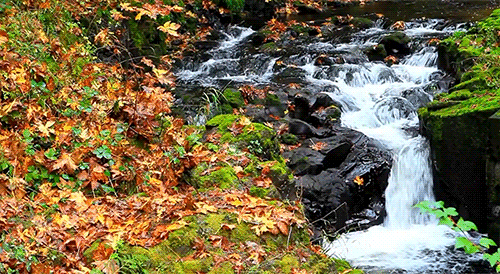



Should rivers have the same rights as people?
Patrick Barkham 🌊 Sun 25 Jul 2021
Around the world, activists are pushing to protect their rivers by giving them legal personhood. Is this just symbolism, or can it drive lasting environmental change?
The Magpie River winds majestically through the forests of Quebec for nearly 200 miles. Its thundering ribbon of blue is cherished by kayakers, white-water rafters and the indigenous Innu people of Ekuanitshit.
Earlier this year, in a first for Canada, the river was granted legal personhood by local authorities, and given nine rights, including the right to flow, the right to be safe from pollution – and the right to sue.Uapukun Mestokosho, a member of the Innu community who campaigned for the recognition of the Magpie’s rights said spending time on the river was “a form of healing” for indigenous people who could revive their traditional land-based practices that had been abandoned during the violence of the colonial era. “People are suffering a lot, with intergenerational traumas linked to the past,” Mestokosho told CBC. As well as this benefit for people, she said that her ancestors had always protected the Magpie, known as the Muteshekau-shipu, in the past, and a recognition of its rights would help protect it for future generations.
The Magpie is one of a growing number of rivers to be recognised as a living entity across the world. The burgeoning rights-of-nature movement is pushing local, national and international authorities to recognise natural features – from lakes to mountains – in law, giving them either legal personhood or an independent right to flourish.
Giving rivers the status of people – or more – in courts of law is enlivening environmentalism around the world. Ecuador started the movement when it enshrined rights of nature in its constitution in 2008. Countries such as Bolivia, Mexico and Colombia have created comparable legal mechanisms to protect nature, while New Zealand, Australia and Bangladesh have acted to protect rivers. In the United States, residents of Toledo drew up a bill of rights for Lake Erie. But can legal rights for nature protect it in reality? Who decides when a river can sue? Does it diminish the power of nature to squeeze it into the western legal system? Or do nature’s rights challenge the very foundations of capitalism?
Western legal thinkers began probing the prevalent Enlightenment assumption that natural objects were simply property to be exploited in 1972 when a young professor of legal philosophy, Christopher Stone, argued that the environment should be considered as a subject and given legal personhood – as granted to corporations, for instance – with human guardians able to seek legal redress if a natural feature is damaged or destroyed. Today’s movement was ignited in 2017 when an act of parliament in New Zealand granted the whole Whanganui River rights as an independent entity, considering it an indivisible whole from source to sea. This was part of the treaty settlement between the government and the Māori people. Guardians were appointed to act and speak on behalf of the river and enforce its rights.
But what is a river? Most would say not its banks but its flowing water. Unfortunately, the “elephant in the room,” says Dr Erin O’Donnell of the University of Melbourne and author of a book on rights for rivers, is the fact that none of the rivers legally recognised as living beings or legal persons actually have any rights to the water that flows within their banks.
“There is increasingly an attempt to give rivers a right to flow and so the Magpie River in Canada has got the right to flow, but how you enforce that right is very unclear,” says O’Donnell. “And if that’s not actually embedded within water law, which it isn’t yet, then it’s probably not worth the paper it’s written on.”
In New Zealand, the Whanganui treaty did not address this key issue, with a water company continuing to divert 80% of the river’s flow for hydropower until its licence expires in 2039. If this fact makes rights for rivers appear to be symbolism without legal teeth, O’Donnell and others argue that the concept still possesses real transformative power. In Canada, David Boyd, a professor of law and the UN Special Rapporteur on Human Rights and Environment, has said that legal personhood could succeed where decades of environmental laws have failed, kickstarting a cultural shift away from conceiving of nature as a “warehouse of commodities for human use”.
In Australia, that shift is underway with regards to the Yarra, believes O’Donnell. The Yarra was recognised as a living, integrated entity as its traditional owners, the Wurundjeri people, had always known it, in a state act of parliament in 2017. Unlike Lake Erie and other locations in North America, the Yarra has not been made a legal person. “The upside of having legal personality is that you do have extra legal powers, so a river that is a legal person can go to court. The downside is that you immediately focus people’s attention on those rights and powers and expect the river to start using them,” says O’Donnell. “One of the first questions that I get asked almost every time I speak publicly about the issue of rivers having rights is, ‘Can we sue the river when it floods?’” As soon as Lake Erie was granted rights in the United States, farmers – concerned that measures to stop fertilisers running into the lake would threaten their businesses – challenged it in court.
Having the Yarra recognised as a living entity sounds like a weaker step than legal personhood, but it still has “the most transformative potential in terms of the way that people relate to the river,” argues O’Donnell. Until very recently, the river was a resource to exploit: a source of water, a stormwater drain and a sewer. “When we see the river as a living being, is that when we start to say, hang on, what do we want for the river? That’s the genuine conversational shift I’m seeing with the Yarra away from this western resource extraction model to seeking a partnership with the river in its own management.”
Some rights-of-nature sceptics argue that it simply can’t fit into western law, which upholds capitalism, property rights and extracting profit from the Earth’s resources. After Ecuador incorporated rights of nature into its constitution, in 2011 a provincial court ruled in favour of the Vilcabamba River against damaging road construction. The river won in court but the developer didn’t actually take the action required to remediate the pollution. Ecuador’s courts have since held more than three dozen lawsuits in the name of nature. Many have been successful but verdicts have not always been enforced on the ground.
In India, a state high court tried to give the Ganges and Yamuna River legal personhood in 2017, but the decision was appealed to the supreme court. Campaigners are still waiting for the verdict while the rivers continue to be polluted and exploited.
Rights of nature are being asserted most powerfully in post-colonial countries where indigenous people strive to protect traditional lands. But some indigenous campaigners view legal personhood and “rights” for nature as western constructs. “The use of rights doesn’t quite fit into the teachings of many indigenous people,” says Michelle Bender of the Earth Law Center, an influential co-operative based in the United States. “Nature is the source of life, it’s already an entity to be respected and so some people say we don’t need this recognition of rights. To be clear, the rights of nature movement is learning from an indigenous worldview rather than the other way around. The use of rights of nature can help to reorient the law around indigenous relationships and responsibilities to nature.”
Europe lags behind other continents where indigenous people have challenged western concepts of owning and exploiting nature. In Britain, nature’s rights briefly emerged in 2018 when Frome town council, run by community-minded independent councillors, proposed to pass a bylaw recognising the rights of their stretch of the River Frome and water-meadows to remain pollution-free. Belatedly, in 2020, central government said that the council could not pass its bylaw because they judged it duplicated existing environmental protections.
Mumta Ito, the founder of Nature’s Rights and a former environmental lawyer based in Scotland, says it is not possible to make local laws in Britain as municipalities can in North America. “Then you get the backlash, the voices that say it doesn’t work,” she says. “Of course it doesn’t work. How can one part of the River Frome have rights when the stretch flowing through the next county doesn’t? All you can achieve with these local-level laws is raise awareness.”
Ito argues that we can’t simply drop the rights of nature into the current legal system, but require much more fundamental change. Ultimately the law must recognise that nature’s rights come first, followed by human rights and then corporate rights because without living systems such as clean water, air and fertile soils there is no human life. “We are an intrinsic part of nature and our human right to life emanates from the rights of nature. All human rights exist because of nature. It’s irrational to say we have rights to life or property rights if nature’s rights are not achieved. But we have an economic system that undermines the natural system that we come from.”
Such radical legal changes would probably require us to uproot established western concepts of property rights, individualism and ceaseless economic growth. “Where do we start?” says Ito. “We should start with common sense. People becoming connected with nature is really going to help. All of us have experienced how good we feel being in the forest or by the sea. It’s hard to get people to care about something if they don’t make the connection.”
Rather than battling at a local level in Britain, Ito is examining how the EU could recognise rights of nature. Ito says EU commissioners and legislators are paying attention. “At least they are willing to hear what we’ve got to say.”
Other rights of nature advocates are also setting their sights higher. Rivers cross state and national borders and most are boundary-less, ultimately flowing into the sea. Protecting oceans looks a particularly daunting task, but Michelle Bender argues that it may be easier to assert nature’s rights here because no one owns the high seas. Rights of nature don’t conflict with property rights so oceans could more easily be recognised as an independent legal entity. “The ocean would own herself and decisions would be made considering her wellbeing and impact on all life, rather than just the piecemeal approach that’s currently used,” says Bender. There could be a seat for the ocean at the UN or a council of ocean guardians who are legally responsible for representing the ocean’s needs. They could set standards for a “healthy” ocean.
In some respects, new rights of nature laws resemble the “net zero” emissions targets set by governments, councils and corporations: worthy aspirations yet to translate into decisive action and change in real life. There is also a chicken-and-egg element to this debate: can law change popular consciousness or is it doomed to fail if it doesn’t simply prop up existing values?
Campaigners believe the law can and does change the way we think. For Ito, her ambitious pursuit of rights for nature is not nearly as frustrating as her years as an environmental lawyer seeking to defend nature using inadequate existing structures. “At least on this I’ll be able to look my grandchildren in the eye and say I did what I could,” she says. “The changes in the legal system deeply affect the psyche. If the law says I’m in relationship with the ocean and the river then it won’t be long before people start behaving as if we are interconnected with the other life forms on the planet.”
🌊💧 💦🌊💧 💦🌊💧 💦🌊💧 💦🌊💧 💦
https://www.theguardian.com/environment/2021/jul/25/rivers-around-the-world-rivers-are-gaining-the-same-legal-rights-as-people?utm_source=pocket-ff-recs
Unlike many others, Guardian journalism is available for everyone to read, regardless of what they can afford to pay. We do this because we believe in information equality. Greater numbers of people can keep track of global events, understand their impact on people and communities, and become inspired to take meaningful action.
We aim to offer readers a comprehensive, international perspective on critical events shaping our world. We are committed to upholding our reputation for urgent, powerful reporting on the climate emergency, and made the decision to reject advertising from fossil fuel companies, divest from the oil and gas industries, and set a course to achieve net zero emissions by 2030.
🌊💧 💦🌊💧 💦🌊💧 💦🌊💧 💦🌊💧 💦
Every contribution, however big or small, powers our journalism and sustains our future. Support the Guardian from as little as $1 – and it only takes a minute. Thank you.
https://support.theguardian.com/us/contribute
🌊💧 💦🌊💧 💦🌊💧 💦🌊💧 💦🌊💧 💦
Tales of the river: the Magpie, also known as the Muteshekau-shipu, has been recognised as a living entity by the Canadian government. Photograph: Peter Holcombe
Deep feeling: in 2017 the New Zealand parliament granted Whanganui River rights as an independent entity, an indivisible whole from source to sea. Photograph: Oliver Strewe/Getty Images
2 notes
·
View notes
Text
Islamic Group ICNA’s School Project Features Individual Who Joked About Threatening to Blow Up School
Syed Ammar Ahmed wrote, “I hate white people”; he called himself a “terrorist”; and at the suggestion of an acquaintance, he joked that he “should have threatened to blow up the school.” Prior to ICNA, Ahmed was an Organizing Director for Emgage

ICNA School Project Features Individual Who Joked About Threatening to Blow Up School
By Joe Kaufman
Radical Muslim Syed Ammar Ahmed continues to affiliate with colleges and kids.
Last month, the Islamic Circle of North America (ICNA) announced its sponsorship of a school project that would provide grants to Muslim teachers and schools in need, what might seem to be an innocuous and laudable undertaking. However, the group sponsoring the project, ICNA, has ties to overseas terror, and the face of the project, Syed Ammar Ahmed, is a radical who once joked about threatening to blow up a school. And to provide a further grim irony, Ahmed is currently an adjunct professor affiliated with different colleges. Why are American youth being subjected to such groups and individuals without so much as an internet background check?
ICNA is the American arm of South Asian Islamist group, Jamaat-e-Islami (JI). JI’s militant apparatuses have caused much murder and mayhem. One former JI death squad leader, Ashrafuz Zaman Khan, who was sentenced to death himself, in absentia, for multiple murders in Bangladesh, is currently active in ICNA and has served for years in ICNA’s top leadership. ICNA has used the web to promote terrorist groups, including Hamas, Hezbollah and the Taliban, and in December 2017, ICNA organized an event featuring Falah-e-Insaniat Foundation (FIF), a US-banned front for Lashkar-e-Taiba (LeT), the group responsible for the 2008 Mumbai attacks.
Syed Ammar Ahmed is the Public Relations and Government Affairs Coordinator of ICNA Relief USA, ICNA’s US-based social service division and the group leading ICNA’s school project. In February 2010, following a debate he participated in at a school, Ahmed wrote, “I hate white people”; he called himself a “terrorist”; and at the suggestion of an acquaintance, he joked that he “should have threatened to blow up the school.” Prior to ICNA, Ahmed was an Organizing Director for Emgage, an Islamist group attempting to disguise its agenda as political advocacy, whose founder and co-chair Khurrum Wahid was reportedly placed on a federal terror watch list.
On January 23rd, ICNA Relief announced, on its social media, the establishment of a grant – “EMPOWER Grant” – allowing ICNA the opportunity to assist Muslim schools and teachers. Accompanying the announcement was a video featuring Ahmed and a remote panel of individuals participating in and discussing the project.
One of the panelists was former President of ICNA Naeem Baig. Baig is currently the Outreach Director of Dar Al-Hijrah, a radical mosque located in Falls Church, Virginia that previously had, as its imam, future al-Qaeda leader Anwar al-Awlaki. Baig was with Dar Al-Hijrah, when its current imam, Shaker Elsayed, in May 2017, advocated for female genital mutilation (FGM). In June 2016, Baig proudly posted on his Facebook page a photo of himself with Mazen Mokhtar, a former admin for the now-defunct al-Qaeda recruitment site, qoqaz.net, who has called Hamas acts “heroic” and suicide bombings “an effective method of attacking the enemy.”
Another panelist was ICNA Spokesperson Saima Azfar. Azfar is a big fan of former Egyptian President Mohamed Morsi, a Muslim Brotherhood operative who died while in prison on charges of espionage. Azfar called his death a “murder,” and after he died, she used his image as her ‘profile picture’ on Facebook and posted a fiery video of him extolling jihad and death. Azfar mourned JI terrorist Mir Qasem Ali, who was hung in Bangladesh for war crimes he committed in 1971. Azfar has promoted a call for freedom for Kashmiri terrorist leaders, and in August 2019, Azfar was caught posting ‘fake’ anti-Indian propaganda on Facebook about Kashmir.
Another panelist was the General Counsel and Deputy Executive Director of the North American Islamic Trust (NAIT), Chicago attorney Azam Nizamuddin. NAIT controls the assets of hundreds of radical mosques throughout the US. Among NAIT-owned mosque alumni are: 9/11 hijacker Hani Hanjour, Boston Marathon bomber Dzhokhar Tsarnaev, and Chattanooga, Tennessee military center shooter Muhammad Abdulazeez. NAIT, along with its affiliate ISNA, was named by the US government a co-conspirator for two federal terrorism financing trials dealing with the Holy Land Foundation (HLF), a now-defunct US charity that raised millions of dollars for Hamas.
ICNA’s school project, which originally began as a giveaway of what appeared to be cheaply made backpacks and school supplies, may seem like an admirable endeavor, but given the terror-linked organization running it and the radicals involved in it, how can anyone see this as being worthy of praise? Indeed, events such as these are only meant to take the focus off of ICNA’s sinister background and camouflage it with a few select pictures of smiling children.
And on top of all this, ICNA chose, as the face of this school project, someone who joked about threatening to blow up a school! Yet, even more absurd is the fact that this same individual is associated with different colleges. According to Syed Ammar Ahmed’s LinkedIn page, he is presently an Adjunct Professor of Political Science at Indian River State College, in Fort Pierce, Florida, and Broward College, in Fort Lauderdale.
ICNA’s terrorism affiliations and its radical operatives are dangers to society and their jihadist activities are threats to our country’s national security. They should not be operating in America, permitted anywhere near an educational institution, nor involved in the lives of children in any way.
--------------------------------------------
PS: Emgage is also part of the Biden administration coup. More in these prior posts.
#Islam#Muslim#Sharia#Jihad#Legal#Law#News#Media#Politics#religion#mosque#Terror#Immigration#Education
3 notes
·
View notes
Text
If writing were breath, I imagine my lungs would implode
“ If you surround yourself in love you're bound to go great places, and though my life has been one of rich soils and silver platters I have found that a life of rich hatred is no life at all. Real royalty is found in the heart not the crown nor jewels.” - Katerine Von Roy
“ We're sparkling stars in a vast eternity of pitch black shadow shining even though the world wants our lights to go dim and our candles to be snuffed by dark waters.” - Katerine Von Roy
"The ashes of ones soul is often created in the fire of another's hatred, the fire of another more often than not will burn another to ash if not contained. I have found you have to control the fire raging inside of you, or everyone around you will suffer the consequences of you striking a match to feel the flame.” - Asbury Hobkins
“ I don't understand why we have to pick up our guns and fight, but our lives are on the line, and when peace isn't an option, bask in chaos to make peace the only damn option available.” - Asbury Hobkins
"If dreams are the very foundation on which we stand then tell me why it is nightmares rule over this land. Light can not prevail without darkness, shadows can't exist without the sun, dreams can't soar without nightmare so tell me why you ignore the foundation of dreams?” - Algonul
“ I will destroy faith and hope with my existence alone.” - Algonul
“ I have dipped my fingers in a river of blood, and just because the man I drowned hurt me so, it gave me no reason to bury him with my pain. But I didn't bury my pain, it only rose from it's coffin and burst from my chest.” - Valarie Forbes
“ If you fear for your life, it's often you'll take another to regain your sense of safety.” - Valarie Forbes
“ I am a beast shackled by nuthin' more than my fucking rage. It beats inside my chest day after day, month after month, year after year, it is an ugly beast, but when did I ever say I was anything but a god damn monstrosity?” - Bernard
“ You wanna be a hero? Kill yourself and spare yourself of the pain I'll inflict ya. The only thing you can change, is how you fucking die." - Bernard
“ I'm in no ways a good man nor am I rich in heart all the money in the world couldn't save me from the sins at my back.” - Sam Dellwotfire
“ "Of all the bullet wounds I've inflicted the ones I shot into my heart are the most painful. I have learned peace is simply an intermission, it's between chaos and sorrow, and I imagine this pocket of peace will never last.” - Novella Delemonte
“ "Bravery ain't not bein' scared, bravery is bein' frightened down ta your very core, feelin' that fear in your bones, and doin' the right damn thing despite the cold shiver of fear runnin' up your spine. I have found that despite the fear in my old heart, I'm runnin' inta the battlefield regardless.” - Walter Hemmington
“ Life is a battlefield, it's a good thing I'm a damn soldier.” - Walter Hemmington
"The weight of a thousand moons weight down on my heart, but I've found a single sun, can make that weight as light as a feather. Emma is my only guiding light, the singular star in the night sky, the sun on a cloudy day, and somehow I've found warmth when all I ever was, was cold.” - Jen Dallinvritz
“ The world tries to keep me down, but I just fly higher, the sun may be in view, but a flame can't burn fire.” - Jen Dallinvritz
“ The pain I feel is nothing compared to the peace I've found.” - Jen Dallinvritz
“ I've been basked in horrors, covered in shadows and told ta be a monster because it's what orcs do. But just because it's what we were made ta be, don't mean we can't re-write our definition.” - Ashgarn
“ You can call me a monster for my heritage, but if you look a lil deeper you'll find that I'm not like other orcs. I'm just an orc in a human's world.” - Ashgarn
“ I have claws meant only for beasts, but you need not be covered in fur and own claws to be a beast. Most of the beasts I've slain are mortals draped in the fur of a wolf. I will gladly graze on the grass of their hunting grounds to be the wolf in sheep's clothing that puts them down once and for all.” - Vivian Swain
“ I shalt redeem us in our final hour, bathe in the darkness only to drown the monsters around me. I'm the last thing you'll see, in the blink of an eye your life will flash before your eyes, and it's final moments will flash before mine as you've seen so many times with the innocent blood you've spilt.” - Vivian Swain
“ To get acceptance I've found you have to go through the struggle of accepting who you are. There'll be nights you can't find any shred of light, nights you scream into your pillow and bat your fists against the wall in frustration. But it's worth it in the end, it is. If you can call yourself beautifully you, than you've succeeded in life.” - Martha Vendowister
“ If you're different, welcome to the club, here we accept everyone no matter what gender they are, no matter who they love or the battle they fight. You can fight depression, anxiety, suicidal thoughts, and if you've won that battle, you're strong as fuck, don't let anyone tell you ya aren't. Because you wake up tired just to fight the same demons that left you tired the night before, and that, is true bravery.” - Martha Vendowister
“ I find that life is worth it despite the scars in my heart, just because my heart aches doesn't mean it's not whole. Just because my mind is scarred, doesn't mean it can't bring me tranquility.” - Octavia Blackroad
"I'm curling back from the recoil of damage done and shots fired into the anomaly of my own heart. It's as vast as the oceans, and I drown in it's depths more often that not. I'm a mystery to even myself, I can't figure out the emotions in my own heart, and I fear I'll be gone and forgotten before the sun rises on the horizon.” - Stefania Saines
“ "You could live your whole life in a cage without once realizing it, or you could find the door was open all along if you just believed in yourself. The only cage you're in is one of doubt, if you doubt everything you can be, there's no key to the cell you've locked yourself in except for belief.” - Avirine Winning
“ You can't make a perception of me reality when it's just a deluded fantasy of your mind.” - Avirine Winning
“ How is it that I've dipped my fingers in the ashes of my family tree and all I find is old rotted bark and a hollow trunk? I find the flame of corruption and sin tore the dying tree asunder, rotted the families history in the most sinful of deeds.” - Merida Calico
“ I've been in the trenches my whole life, but never was I the one hiding, always was I the one pulling the damn trigger.” - Merida Calico
“ I've slaughtered innocent men and women, my lips taste of death and a desire to be loved.” - Merida Calico
“ I've been fightin' all my life, ain't no peace ever found in world war me, but I've found as long as I hold my head high, and soldier on, I'll breakout of the heart of darkness and find the light I seek.” - Alec Crabill
“ I've been through every fight imaginable, fought drug lord's in Bangladesh, rescued women and children from odds you don't wanna face unless you got a damn death wish. But here I am, beckoned by death yet bathed in life.” - Alec Crabill
“ I've been faced with many battles, the loss of my mother, ones fought with words and gunshot lullabies and serenades of violence and bloodshed. But here I am, singing a melody of love despite the hatred drowning out everything else.” - Jade Falls
“ I look into his eyes, I see pain, I see love and I see the world. He's everything I've ever wished to have, and here he is, loving me deeper than the ocean.” - Jade Falls
“ I once believed my parents house was a cell with no key, and yet my sister Emily, and her wonderful wife Lacey didn't need no key. They blasted a hole through the walls and broke me the fuck out.” - Alice Everest
“ The world ain't gone cold, we've just forgotten how to start a damn flame and ignite a spark. So live damn it, live." - Alice Everest
“ "I have been so consumed by shadow I imagine I've grown an appetite for it. I have found in the coldest of nights, I dance upon star dust and twirl through the ashes of planets I once called home.” - Night Sparrows
“ All I have are bad thoughts soaked in bad intentions. I often wonder how it is I ever survived when my mind wishes me to die. I fight, I scratch, I tear. And yet still I find only shadows.” - Night Sparrows
“ I dance in the blood of myself and bleed dry the girl I was.” - Violincia Bloodwort
"Here I am, choking on the numbness I feel, singing gunshot lullabies and serenades of nothingness. I in of myself, am a vacancy of everything my mother thought I'd be.” - Varkos Shevelwix
“ I'm not quite righteous, not quite cruel I'm the grey area in-between. Somedays I'm colder than ice, others I wish naught to harm even a fly. I'm a duality of good and evil and I ponder on which shall win the war I wage with myself." - Varkos Shevelwix
“ Here I stand, in the ruins of Atlantis, swimming through the tide of lost life and spilt blood.” - Lawrence Gallagher
“ That man ain't human, far as I'm concerned if you don't got no humanity you're a beast, and here, we put down beasts who god damn bite.” - Lawrence Gallagher
"Ya know, I've learned the world don't much got sympathy for the living, and the living don't much got sympathy for the dead. We disrespect those that have passed, and destroy their legacy with rifles loaded with cruel remarks.” - Benedict Collins
“ It takes a lot 'a bravery ta accept yourself, let alone trust another ta accept you.” - Benedict Collins
"I ain't no saint, I've fought everything I ain't and I imagine somewhere along this broken path I found who I am. I've tasted one too many lips against mine, let too many cigarettes burn my lungs ta ash, but who said ya oughta be a saint to make it in the world huh?” - Becky Winters
“ Life is a constant struggle, but you don't succumb to it's damn riptide.” - Becky Winters
"All my life I imagine I've been told to be who I'm not, I find it impossible to find yourself if all your life all you've ever been was a spectacle of someone else.” - Sarkelus Johnnson
“ Karma is bound to catch up with me eventually, a man such as myself can't outrun her, only delay the inevitable.” - Sarkelus Johnnson
“ Oh how I wish I was strong. I could lift a blade, but I could not bring it down.” - Ashel
“ I don't believe in blood spilt for a good purpose. If it was so holy then it wouldn't be a damning offense.” - Ashel
“ We all lose ourselves at some point, but if you lose who you were, journey to find who you oughta be.” - Dory Villsworth
“ Life ain't darkness and darkness ain't life. It's just part of it. So get your shit together and move the fuck on with life. Don't let your past be an anchor, and don't be a ship at the bottom of the ocean.” - Dory Villsworth
"Most would rather drown in a blood soaked lie than choke on the truth.” - Simon Rossburg
“ I'm the monster this world needs, Mike Wazowski in a world full 'a Randalls.” - Simon Rossburg
“ Ya oughta sin ta win sometimes, that's just the cold bitter truth, and if ya can't swallow it, you're gonna damn well choke on it and die in the process 'a accepting it.” - Simon Rossburg
“ I ain't a part of my scars, they're a part of me. Sure, they hurt like Hell, but let 'em hurt, what's important is I let 'em fuckin' heal." - Carl Schillerstrom
“ This world would like to kick us down on the constant, but screw that, I'm not going down without a damn fight. I've been fighting all my life, what's another punch thrown huh? What's another damn bruise? I got plenty, yours won't hurt as bad as other's.” - Malilah Vivenwoker
"I'll weave this pain of mine into gold and these scars into strength.” - Kerrissa Vivenwoker
“ I've learned the world don't care about you, unless you care about yourself. Because you'll get nowhere if you feel sorry for yourself, you have to rise up and be your own armor sometimes. Sure, it may be rusted, but who said rusted armor can't stop a sword?” - Kerrissa Vivenwoker
"Life has made me a gentle soul, though it was rough with me, I remain the softest spoken love in the air.” - Madison Rose
“ Love is a wonderful thing, it can make someone who's fallen to pieces whole. Someone who's fallen climb, and someone who feels nothings worth worth a million gold coins.” - Madison Rose
"I carry on despite the daggers in my back, you may bleed, but don't let your scars steal every drop of blood you have.” - Sabrina
“ Life will prosper as long as you let yourself grow. You're a flower, not a weed. Remember that. You aren't poisoning your own petals, you're watching them fall, and not picking them back up. So bloom, and remember, even the smallest seed, can become the most beautiful flower." - Sabrina
“ Oh mother dear I know you yearn to see me use this power of mine for good, oh sister dear how you wish I'd protect you from the heat of this world's hate, but all three of us burned. And dying changes a woman.” - Autumn Wolfmoon
“ I see their father in everything they do, their smile, their spunk attitude, sometimes I feel I'm haunted by Dominic's memory, but then I remember even ghosts can be friendly.” - Martha Honeycomb
“ Oh how Delilah makes my heart soar. My beautiful Amish girl. She lives life so simply, she cherishes every little moment, and I cherish every little moment I have with her. She's showed me just how amazing life can be.” - Laura Hollinger
“ My life's been dark, it's been crummy, but ya know what? I rose in spite of that. I won't let my scars define me, I'll define my damn scars.” - Laura Hollinger
“ Life has been a rather interestin' ride, once I believed I had ta choose between my old lifestyle, and dis new one dat had found me. But I found dat I have ta combine da both of them, because they're both a part of me, and I imagine neither side will leave my heart. If you are faced with choosin' who you were, and who ya are, I advise you combine the two, and become the beauty you are ta be." - Delilah Miller
"Black rain pitter patters against my heart and soul, I imagine it drowned the noble man I was, and out rose the wicked and corrupt creature of the storm inside my bones.” - Theodora Crimsonburn
“ I imagine my daughters can't look up to me. Despite how I protect them so, I forgot to protect my heart, and I imagine that's why I lost it.” - Theodora Crimsonburn
“ "If it is only human to sin, tell me why it is I am labeled monster. In all of my monstrosity I find I am only human, and oh, isn't that the most terrifying thing of all? My lack of humanity, yet despite all that, being human?” - Quentin Satchel
“ Redemption was never an option, because I was born on the edge of Hell, but stepped on other's backs to reach Heaven.” - Quentin Satchel
“ Every life taken to me is just.. another Tuesday. It's a chore, one I fulfill only to get back to my task at hand.” - Quentin Satchel
"My memory is a peculiar place, forgotten are the scars of my past, but wonderous are the joys in this life of mine.” - Joe Paquil
“ I have found this world will kick you around some before it gives you peace of mind, but don't let the kicking kill ya. As a bull rider wouldn't let the tussle kill him, you won't let the fight for the reward kill you.” - Joe Paquil
“ Cold waters can only freeze you if you jump in. And if you're pushed, you fight to get out.” - Joe Paquil
“ Life can be a struggle, God... how I know how difficult it can be. But in the end, you'll realize struggle is a part of life, and it's only a small part of it. You may get kicked down on the constant, but one day you'll rise, and you're gonna do it with a frikkin' smile! Okay?” - Sandra Crumbs
“ "Oh I imagine the echoes of gunfire and sin ring in my ears, and all I ever was is consumed by a sinful melody, it's chorus one of broken bones, and it's bridge one of spilt blood.” - Nestor Bevelricks
“ Ya know, I asked God where the hell he went, and the only answer I got was a cool breeze in the midnight air.” - Nestor Bevelricks
"I've found the difference between a loving God and a cruel one is your perception of cruelty." - Nestor Bevelricks
“ She is da beauty ta my beast. Da rose ta my thorn. And da plant in me garden 'a weeds. All it takes is one flower ta make a garden bootiful.” - Stephen Vail
“ I 'ave learned doe my anger is strong, I am stronger.” - Stephen Vail
“ Amber is da moother I never 'ad, though I've heard of the woman who gave me life, and from what I can see, Amber is everythin' she'd eva' wish ta raise. Thorne, despite 'er damn struggles wif' 'er mental illness, takes care of those around 'er. And Jesse? Despite 'er fear, she stays fokin' brave as a captain sailin' straight inta da eye of da hurricane.” - Stephen Vail
“ I wasn't born with this killer body. I had to fight for it. I had to pay for it. It was fucking expensive. But you know what? I'd give away all the money in the world to be myself.” - Emanuel Trueblood
“ Only the dead 'ave seen the end of war I imagine, they got peace, we have ta carry war on our shoulders every damn day. The weight of it is impossible ta lift, and yet ya do it anyways.” - Deandra Phoenix
“ Ain't who I were. Not no more. Just a coffin, I imagine. Lower me down, bury me underneath America's soil and remember I once stained it crimson, but blood seeps through the dirt and is often forgotten.” - Deandra Phoenix
“ The hauntings of war echo on the cool night air. The fire reminds me of the sparks of my revolver, the night sky reminds me of the starless nights spent on the battlefield, and the dirt reminds me of the bodies buried. Everything is a reminder of war. Once you've fought it, you can't ever stop fighting it.” - Deandra Phoenix
"Life don't gotta be perfect, just lived to it's fullest extent. And besides, if you live your life to it's fullest, isn't that perfect despite the struggles?” - Brandon Killovitch
“ She saved my life.. and I imagine I saved hers. She used to be a train-wreck, but, so did I. But together, we fought each other's battles, she still has that wild side, but it makes her her, and I accept everything she is, because she's beautiful and I'm in love with everything she was, everything she is, and everything she'll become.” - Brandon Killovitch
"I'm nothing short of sinful, just a bonfire with kerosene swallowing everything around her whole, burning down the fields of her innocence in one fell swoop.” - Kareath Calico
1 note
·
View note
Text
Rhinos in China: Though rhinos are currently extinct in China, here are some new-ish maps and research on the surprisingly widespread distribution of rhinoceros species living in China during recent historic times, prior to large-scale human geoengineering and environmental change
*Spins wheel* Uhhh today’s hyperfixation is: distribution maps, just like every day. But this time, it’s maps related to East Asian environmental history and the anthropogenic extinction of rhinos. Or whatever. Have this stupidly long and completely unsolicited post, I guess.
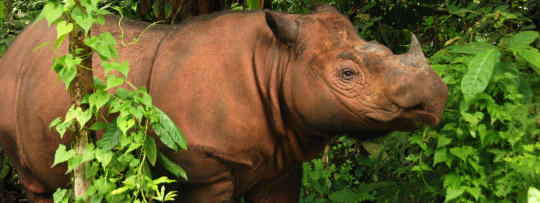

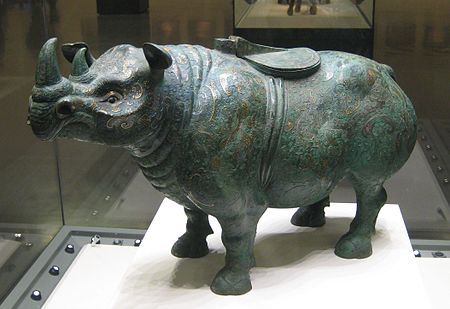
Today, rhinos are extinct in China. The presence of rhinos in China during historical times - and the scale of their distribution range - has been a bit ambiguous, at least to Western/European audiences, though Chinese art and scholarship has long incorporated rhinos. Though modern, living rhinos seem to be associated with tropical and subtropical biomes in the popular consciousness, the Sumatran rhinoceros (Dicerorhinus sumatrensis) apparently didn’t mind the seasonal snow and cold of temperate climates. About only 3,000 years ago, the Sumatran rhino was apparently still present throughout most of China, as far north as modern Beijing; even as recently as 100 AD, this rhino was probably still present as far north as Shanghai.
The phrase “retreat of the elephants” has sometimes been used to describe the process of human-caused environmental change and landscape alteration that dramatically remade the Chinese landscape over the past 3,000 years especially. (”Retreat of the elephants” is a term borrowed from environmental historian Mark Elvin.) It is relatively well-known that Asian elephants (Elephas maximus), which at the beginning of major Chinese state-building and irrigation projects about 3,000 years ago still lived as far north as Beijing, were gradually driven further and further south, away from the Yellow and Yangtze rivers. Recent research, though, shows that Sumatran rhinos also suffered a similar fate. A “retreat of the rhinos” if you will.
The two rhinoceros figurines pictured above are pieces from ancient China. The first image is in the public domain and depicts a rhino-shaped ritual wine vessel made of bronze, from about 1100 to 1050 BC, during the Shang era. The piece is housed at the Asian Art Museum of San Francisco, The second image is another bronze wine vessel from a site in Shaanxi Province, this time inlaid with gold and hailing from later in history during the Western Han period, about 205 BC to 10 AD. [Photo by Wikimedia user Babel/Stone.] The rhinos in both of these pieces are depicted with two horns, meaning that they likely depict the Sumatran rhinoceros; this is corroborated by the existence of fossil remains of Sumatran rhinos from across China prior to 1000 AD. [The header photo above depicts a living Sumatran rhino on the island of Sumatra. Photo by Bil Konstant and International Rhino Foundation.]
Here behold a Sumatran rhino - and a calf! [At Sumatran Rhino Sanctuary on the far southeastern edge of the island. Photo by S. Ellis, via PBS.]
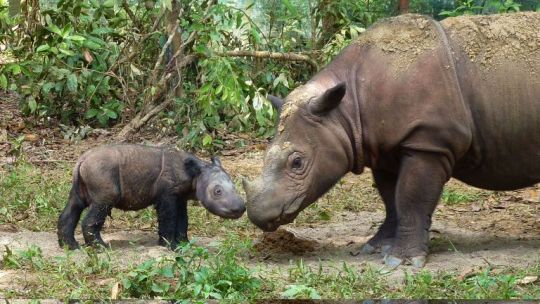
A Sumatran rhino. [Photo by Mark Carwardine and WWF.]
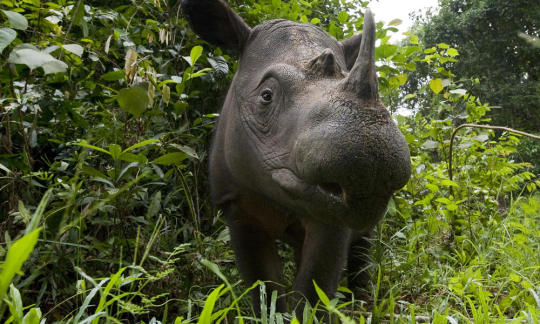
-
Here are some maps and other recent research resources about 3 of the rhinos living in China in recent history.
At the end of the last Ice Age of the Pleistocene about 11,500 years ago and during the advent of so-called agricultural civilization, China was apparently still home to at least 3 species of rhino: the woolly rhinoceros (went extinct around this time); Javan rhinoceros; and, by far the most widespread species, the Sumatran rhinoceros. (To be fair, it is proposed that a 4th species - the famous Indian rhinoceros, Rhinoceros unicornis, now the most relatively stable of the Asian rhino species - was potentially historically present in small pockets of China’s Yunnan Province up until the 20th Century.)
(Rhinos don’t observe arbitrary human-made national borders. I don’t like observing national borders especially when discussing biogeography and ecoregions, so here I’m referring to “China” as the geographic space which was in the cultural sphere of influence of a Chinese dynasty/state between the Shang era and the early 20th Century; centered on the Yellow and Yangtze rivers; and basically including landscapes north of Vietnam, east of Tibet/Taklamakan, and south of the Gobi Desert.)
-
Woolly rhinoceros (Coelodonta antiquitatis)

This is a reconstruction of a woolly rhinoceros, housed at the Natural History Museum in London. Photo by Emoke Denes.
Here’s a distribution map of known sites where woolly rhinos still lived in the Late Pleistocene (up to about 11,500 years ago), at the time that humans were planting and domesticating food crops.

This map comes from a neat report on Late Pleistocene megafauana and ecology in China: “Three abrupt climatic events since the Late Pleistocene in the North China Plain” from Lin Jingxing et al., 2013.
Woolly rhinos may have died out around this same time at the end of the Pleistocene (11,500 YBP), a little too early to have been depicted widely in Chinese art. (Some radiocarbon dates of woolly rhino remains in nearby Siberia, however, suggest the rhino could have persisted into the Holocene until the climatic reversal of the Younger Dryas period, about 10,000 YBP or 8,000 BC.)
-
Javan rhinoceros (Rhinoceros sondaicus)
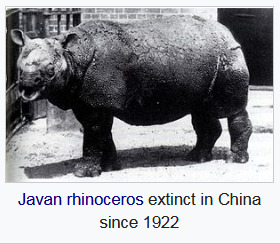
[Thank you, Wikipedia.]
There are less than 100 Javan rhinos that still exist, living only in Ujung Kulon National Park on the far western tip of Java. Here’s the distribution range of the Javan rhinoceros in recent history before its terrible decline [map by Wikimedia user JayHenry]:
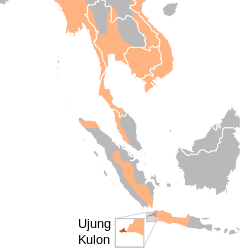
During the past 150 years, the Javan rhino still lived all across Southeast Asia, from India and Bangladesh through Vietnam and into Indonesia. Historically, the Javan rhino likely used to live along the southern China coast west of Guangzhou and Hong Kong. Since the species seems to prefer humid tropical environments, it’s unlikely that the Javan rhino lived any farther north into China during historic times.
-
Sumatran rhinoceros (Dicerorhinus sumatrensis)
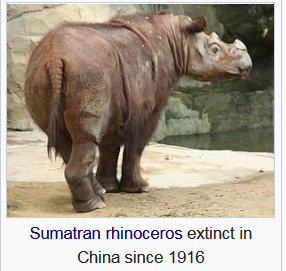
[Thanks again, Wikipedia.]
Here we are. Unlike other rhino species which either went extinct during the Pleistocene or only occupied the humid, tropical southern fringes of China, the Sumatran rhino lived throughout most of China. This is the species likely depicted in historic Chinese art and from which rhino-hide armor was made. Occasional poems from early China also seemingly make reference to the presence of rhinos.
Here’s the current distribution of the Sumatran rhinoceros, contrasted with the early 20th Century distribution [map by Wikimedia user Jay/Henry, adapted from Foose 1997 and Dinerstein 2003]:

Note that the Sumatran rhino currently lives nowhere near China. Until 1916, the Sumatran rhino had lived in Yunnan Province in far southern China along the Myanmar and Indian borders with China. This map is misleading, however, since the Sumatran rhino was present across the majority of China during “historic” times. Recent Chinese scholarship confirms that the Sumatran rhinoceros was much more widespread across China before 1000 AD.
During the past 3000 years, the Sumatran rhino evidently lived as far north as Beijing, in northern China. Here’s a map of recovered Sumatran rhino fossils throughout China, including an approximation of their distribution range over time.
The real historic distribution of Sumatran rhinos in China:
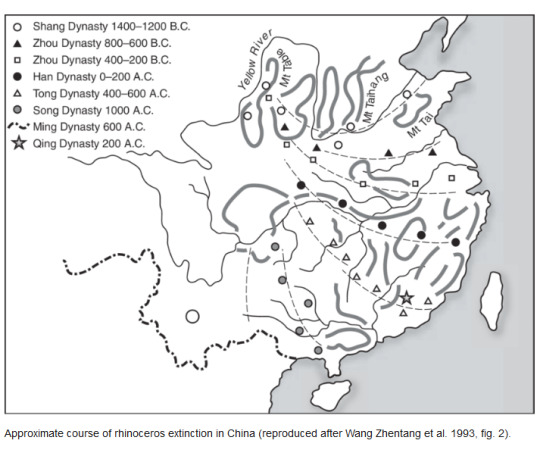
I edited the map a little:
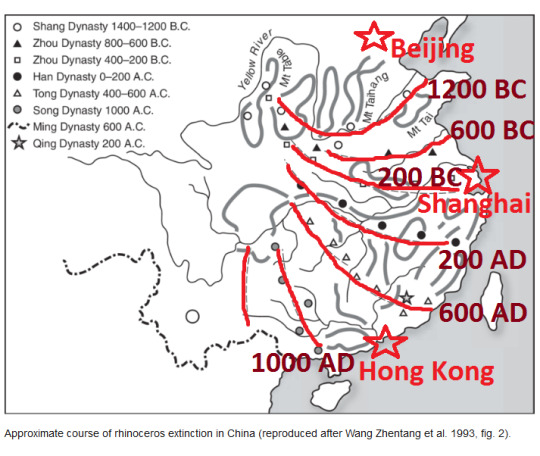
During the Shang era (1400-1200 BC), Sumatran rhinos were still present near Beijing and the Yellow River. By the famous Han Dynasty and the so-called unification of a Chinese “empire” around 50 AD, Sumatran rhinos had been pushed south to about the Yangtze River and Shanghai. By about 1000 AD, the species had been pushed farther south, near Guangzhou and Hong Kong.
This map uses fossil presence of Sumatran rhinos to approximate the historic extent of their distribution in China. The map comes from a great summary of the historic distribution of rhinos in China: “Distribution and extinction of the rhinoceros in China: review of recent Chinese publications” from Kees Rookmaaker, published in Pachyderm, 2006.

[A Sumatran rhino. Photo by Sumatran Rhino Sanctuary via WWF.]
Check out this link to read more about the history of rhinos in China.
Thank you for participating in this hyperfixation.
117 notes
·
View notes
Photo

Happy birthday, Queen Rania of Jordan!
August 31, marks the birthday of Queen Rania Al Abdullah, rounding off another year spent working alongside King Abdullah II in the service of the Jordanian people, and contributing toward his vision for a thriving kingdom.
Over the last two decades, Her Majesty has demonstrated an unwavering commitment to education, stemming from her belief that universal access to quality education is a cornerstone to achieving social justice. The Queen has launched a number of initiatives aimed at enhancing education in Jordan and across the region, with a particular focus on teacher training and tech-based teaching methods. (Source: Petra)
Queen Rania’s passion for education is channeled largely into her work with the Queen Rania Foundation for Education and Development (QRF), a leading regional resource and incubator for innovative ideas in the field. The Foundation strives to improve the quality of education and learning outcomes through several programs, at the forefront of which is its open online learning platform, Edraak, which has reached more than 2.3 million learners to date.
Following Edraak’s successful launch as an adult learning platform in 2014, Her Majesty began cultivating relationships with international organizations, seeking partners who could help her realize her ambition of expanding the platform to meet the needs of the region’s youth.
In collaboration with Google’s humanitarian arm, Google.org, and with the support of the Jack Ma Foundation, Edraak launched its new K to 12 platform in 2016, and began rolling out online curricula earlier this year. The platform makes free, high-quality education accessible to millions of children across the region, including those who are out of school due to conflict or displacement.
Her Majesty’s many other efforts to advance education include the establishment of the Queen Rania Teacher Academy (QRTA) in partnership with the Ministry of Education and Teachers College of Columbia University. Through its pioneering pre-service diplomas, the Academy equips educators with the skills they need to navigate the educational environment.
The Queen is also the founder of the non-profit Al-Aman Fund for the Future of Orphans, which provides adult orphans with opportunities to obtain higher education or vocational training.
Her Majesty travels extensively across Jordan’s governorates, making regular field visits to the nation’s cities and villages to spend time with Jordanians from all walks of life. She is a strong supporter of entrepreneurship and innovation, particularly among the nation’s young men and women, often extending her support to ambitious youth and helping them unleash creative solutions for the world’s challenges.
Queen Rania also continues to support Amman Design Week (ADW), a citywide event aiming to establish Amman as a regional hub for innovation and experimentation by showcasing the talents of local, regional, and international designers. In addition to promoting design thinking and knowledge exchange, ADW also empowers designers and craftspeople year-round through learning programs, direct mentorship, and personalized guidance.
Furthermore, the Queen was one of the first public figures in the region to speak out against the scourge of child abuse. Through the Jordan River Foundation (JRF), a non-profit founded by Her Majesty to promote child safety and community empowerment, she oversaw the establishment of the JRF Child Safety Program as well as Dar Al Aman, the region’s first-of-its-kind child safety center for victims of abuse.
An active humanitarian, Queen Rania is a passionate advocate for refugees around the world. She consistently extends her support and solidarity to children and families displaced by war and persecution, and has visited refugee camps in Jordan, Greece, and Bangladesh.
At the global level, Her Majesty has been recognized repeatedly for her efforts to shed light on the plight of the world’s refugees, improve children’s access to education, and promote acceptance between people of all cultures. The Queen also serves as a member on the United Nations Foundation and the World Economic Forum’s board of directors, and the International Rescue Committee’s Board of Overseers.
9 notes
·
View notes
Link
Excerpt from this article from the The Revelator, published in Nation of Change:
“God knows what will happen. We know the end is coming.”
These were the words of Saber Saladas, a Bangladeshi fisherman and farmer, after his village, home and livelihood were destroyed by floods last year.
Saladas is just one of 8 million people in Bangladesh who have become climate refugees in their home country — forcibly displaced by flooding, river erosion and saltwater intrusion.
“Once, [my] village was green with paddy fields,” he told the Environmental Justice Foundation from an inland shelter after he and his family had fled their home. “But now the water is salty and the trees have died. We can only farm shrimp… We just want to breathe, to live a long life.”
As it stands there’s no clear-cut legal definition for people like Saber Saladas. Although they’re unable to stay in their homes due to both immediate danger and/or an inability to survive there (as is the case when food sources and livelihoods are ruined by inhospitable conditions), they’re not covered by the global “traditional refugee” model.
This model was established by the 1951 Refugee Convention, which states that people may claim their right to asylum if they have a “genuine and well-founded” fear of being persecuted to the point that their life and safety are threatened. This persecution can be for any reason, but common grounds tend to be based on religion, sexuality, political belief or gender identity.
The issue with this longstanding definition of a “refugee” is that the environment does not personally persecute people or communities. There are certain demographic groups, such as working-class and poorer communities, that are more prone to being environmentally displaced, but nature itself is arbitrary. Because of this, legally defining displaced people becomes difficult.
According to a report commissioned last year by the European Parliament, 26.4 million people have been displaced by floods, windstorms, droughts and earthquakes every year since 2008. Notably, this period has seen the fastest acceleration in recorded global temperatures, marking a clear link between climate change and environmental displacement.
And the situation is only going to get worse.
6 notes
·
View notes
Text
Sights in India That Should Definitely Be on Your Bucket List
Top-Rated Tourist Attractions in India . Written by Andy Miller .
1 .The Taj Mahal, Agra
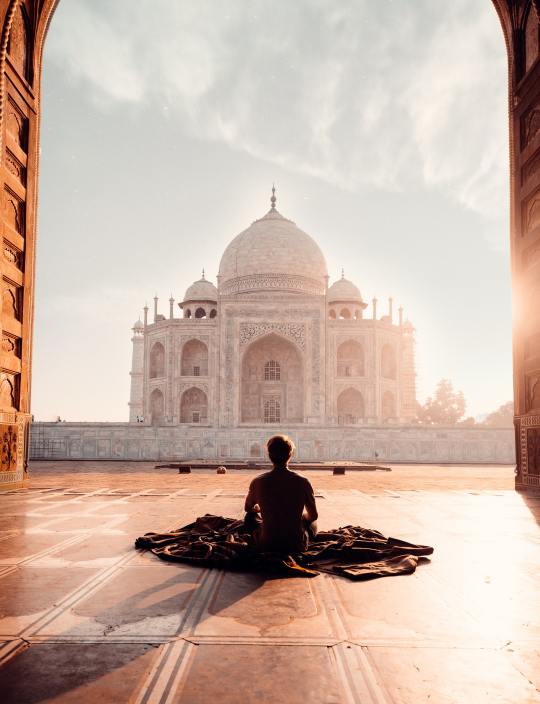
Most likely India's most recognizable building, the Taj Mahal can be the world's most famous testimony to the power of love. Given its name Mumtaz Mahal, the favorite wife of Emperor Shah Jahan, this most beautiful of mausoleums was begun upon the death in 1631 and took 20, 000 workmen 22 years to complete. Incorporating many elements of Islamic pattern including arches, minarets, an onion-shaped dome, and charcoal calligraphy inlaid around the entrance, the Taj Mahal is basically constructed of white marble decorated with delicate inlaid floral patterns and precious and semi-precious stones such as jade, lapis lazuli, diamonds, and mother of pearl. Popular Tip: The best time to visit is either at dawn or gloomy when the atmosphere is brilliantly altered by the change in lighting style (if possible, try to catch a view of the Taj Mahal's reflection from the far bank of the Yamuna River).
2. The Red Fort, New Delhi
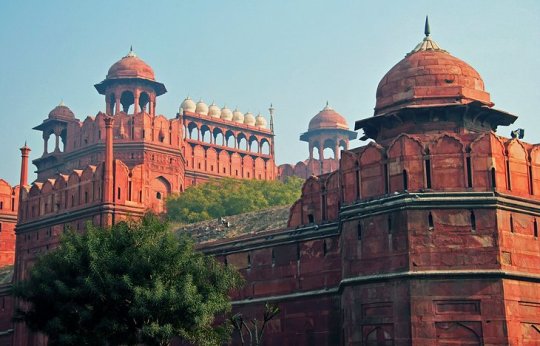
Lal Quila, Delhi Overview
The Red Fort is a ancient fortification in the national capital of New Delhi. Located in center of the city, it was the main residence of the emperors of the Mughal dynasty. It was constructed by Shah Jahan in the year 1939 as a result of a capital shift from Agra to Delhi. This imposing piece of architecture derives its name from it has the impregnable red sandstone walls. In addition to accommodating the emperors and their households, it was the ceremonial and political heart of the Mughal state and the setting for events certainly impacting the region. Today, this monument is home to a number of museums that have an assortment of precious artifacts on display. Every year, often the Indian Prime Minister unfurls the national flag here at the Independence Day.
Formerly known as Quila-e-Mubarak or the Giving Fort, the Red Fort lies along the banks with the river Yamuna, whose waters fed the moats associated with the fort. It was a part of the medieval city of Shahjahanabad, popularly known today as 'Old Delhi'. The entire fort complex is said to represent the architectural creativity and splendor of Mughal architecture. With so much history and heritage regarding it, the Red Fort is one of the most popular monuments with India and a major tourist destination in Delhi. It became a UNESCO world heritage site in 2007. Often the Archaeological Survey of India is at present responsible for the protection and preservation of this magnificent monument.
3 . Gateway of India, Mumbai Overview
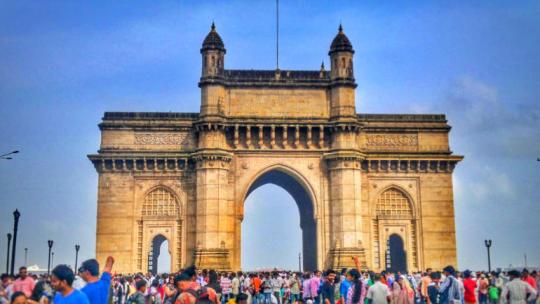
The Gateway of India is, without doubt, one of the most popular tourist destinations of Mumbai. Sitting proudly on the Apollo Bunder, it overlooks the Arabian Sea. It is one of the defining monuments of the city of Mumbai and was built in the year 1924. The construction was undertaken by the famous architect George Wittet, to commemorate the visit of King George V and Queen Mary to Mumbai. The imposing structure of the monument is a beautiful confluence of Indian, Arabic and Western architecture and has become a popular tourist hub in the city. It is also the starting point of a number of ferry services that ply to the historic Elephanta Caves.
Nicknamed 'Mumbai's Taj Mahal', the foundation of this landmark was laid in 1911 and it was inaugurated 13 years later in 1924. The structure in itself is a made of yellow basalt and solid concrete and is embellished with numerous Muslim and Hindu motifs as well. The basalt arch of the Gateway served as the entry and exit access to India through waterways before independence and was the exit point from where the last British ship left India for England. There are statues of Swami Vivekananda and Chhatrapati Shivaji that have been installed near the Gateway as well. The view from the sea of the Gateway complex, especially at night is quite ethereal and beautiful. The Gateway of India is thus, not only a historic artefact but an example of marvellous architecture in itself!Photos of Gateway of India
4. Victoria Memorial , Kolkata Overview

Another relic of the British Raj in India, the Victoria Memorial is located in the heart connected with Kolkata, in West Bengal. This white marbled riche structure was built in memory of Queen Victoria to express her 25 years of rule over India and is pretty much a replica of the Victoria Memorial in London. Victoria Memorial is undoubtedly an iconic structure that is synonymous with the city of joy!Often the memorial is surrounded by a lush green and well-maintained garden, which spreads over 64 acres and has a number of statues and sculptures in it. A sixteen-foot tall bronze statue of victory, mounted on ball bearings at the top of often the memorial, serves to heighten the overall appeal and grandeur with the entire complex. Victoria Memorial is breathtaking and outstanding, especially at night, when it is illuminated. The Sound and Light shows that take place in the evening are an added delight, and a must observe. All in all, the place is a must visit for people to wish to relive the essence of the Victorian era in the modern day world.
5. Home of the Bengal Tigers "Sundarbans Tourism”

Known for hosting the biggest mangrove forests in the world, Sundarbans National Park is located in West Bengal, India. It is also a Tiger Reserve and a Biosphere reserve that provides a complete nature's circle to the tourist right from 'Royal Bengal tigers' to roaring rivers and beautiful estuaries. Sundarbans National Park is a part of Sundarban delta that is covered with Mangrove Forest and the largest population of the Bengal Tigers. It is a UNESCO world heritage site with a large variety of birds and reptiles including salt-water crocodile.
Shared between India and Bangladesh, the Sundarbans meaning beautiful forest, have been declared a UNESCO heritage site. This area has a silent charm that manages to amaze one with the simplicity and naturalness of its ecological balance in spite of offering habitat to some of the most dynamic and awe-inspiring flora and fauna. They are in fact the last remaining stands of the mighty jungles which once covered the Gangetic plain and the sustainability of this natural structure is pretty majestic. Since 1966, the Sundarbans have been a wildlife sanctuary, and it is estimated that there are over 400 Royal Bengal Tigers and about 30, 000 spotted deer in the area.
This forest has the largest number of Sundari trees. Sundarbans epitomize wilderness with its meandering rivers, springs, creeks and estuaries. It is a declared Tiger Reserve, home to the Royal Bengal Tiger- an almost extinct species who swim in the saline water and are often man-eating varieties.
Other endangered species in the Bioreserve are Batagur baska, King Crabs, Olive Ridley and Turtle. You can also find the jungle fowl, giant lizards, spotted deer, wild boar and crocodiles in these forests. The Siberian ducks are another famous attraction here. Besides this, there are over 64 varieties of Mangroves such as Goran, Genwa, Dhundal, Garjan, Kankra, Sundari and Passur. Make sure to hit the Nilkamalor Hiron Point and Katka viewpoints that offer fantastic views of animals in the wilderness. Also, enjoy the mud-flats called Chargheri Char where you can enjoy coastal trekking.
1 note
·
View note